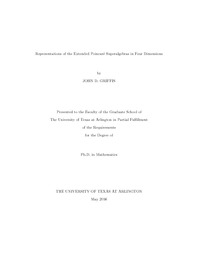
ATTENTION: The works hosted here are being migrated to a new repository that will consolidate resources, improve discoverability, and better show UTA's research impact on the global community. We will update authors as the migration progresses. Please see MavMatrix for more information.
Show simple item record
| dc.contributor.advisor | Grantcharov, Dimitar | |
| dc.creator | Griffis, John David | |
| dc.date.accessioned | 2016-09-28T17:39:58Z | |
| dc.date.available | 2016-09-28T17:39:58Z | |
| dc.date.created | 2016-05 | |
| dc.date.issued | 2016-05-13 | |
| dc.date.submitted | May 2016 | |
| dc.identifier.uri | http://hdl.handle.net/10106/25883 | |
| dc.description.abstract | Eugene Wigner used the Poincare group to induce representations from the fundamental internal space-time symmetries of (special) relativistic quantum particles. Wigner’s students spent considerable amount of time translating passages of this paper into more detailed and accessible papers and books.
In 1975, R. Haag et al. investigated the possible extensions of the symmetries of relativistic quantum particles. They showed that the only consistent (super)symmetric extensions to the standard model of physics are obtained by using super charges to generate the odd part of a Lie superalgebra whos even part is generated by the Poincare group; this theory has become known as supersymmetry. In this paper, R. Haag et al. used a notation called supermultiplets to give the dimension of a representation and its multiplicity; this notation is described mathematically in chapter 5 of this thesis.
By 1980 S. Ferrara et al. began classifying the representations of these algebras for dimensions greater than four, and in 1986 Strathdee published considerable work listing some representations for the Poincare superalgebra in any finite dimension. This work has been continued to date.
We found the work of S. Ferrara et al. to be essential to our understanding extended supersymmetries. However, this paper was written using imprecise language meant for physicists, so it was far from trivial to understand the mathematical interperetation of this work.
In this thesis, we provide a “translation” of the previous results (along with some other literature on the Extended Poincare Superalgebras) into a rigorous mathematical setting, which makes the subject more accessible to a larger audience. Having a mathematical model allows us to give explicit results and detailed proofs. Further, this model allowes us to see beyond just the physical interpretation and it allows investigation by a purely mathematically adept audience.
Our work was motivated by a paper written in 2012 by M. Chaichian et al,
which classified all of the unitary, irreducible representations of the extended Poincare superalgebra in three dimensions.
We consider only the four dimensional case, which is of interest to physicists working on quantum supergravity models without cosmological constant, and we provide explicit branching rules for the invariant subgroups corresponding to the most physically relevant symmetries of the irreducible representations of the Extended Poincare Superalgebra in four dimensions. However, it is possible to further generalize this work into any finite dimension. Such work would classify all possible finitely extended supersymmetric models. | |
| dc.format.mimetype | application/pdf | |
| dc.language.iso | en_US | |
| dc.subject | Branching rules | |
| dc.subject | Induced representation | |
| dc.subject | Supersymmetry | |
| dc.subject | SUSY | |
| dc.subject | Representation theory | |
| dc.subject | Mathematical physics | |
| dc.subject | Group duality | |
| dc.subject | Invariant theory | |
| dc.subject | Representations of Lie Superalgebra | |
| dc.subject | Lie algebra | |
| dc.subject | Irreducible representation | |
| dc.title | Representations of the Extended Poincare Superalgebras in Four Dimensions | |
| dc.type | Thesis | |
| dc.degree.department | Mathematics | |
| dc.degree.name | Doctor of Philosophy in Mathematics | |
| dc.date.updated | 2016-09-28T17:42:06Z | |
| thesis.degree.department | Mathematics | |
| thesis.degree.grantor | The University of Texas at Arlington | |
| thesis.degree.level | Doctoral | |
| thesis.degree.name | Doctor of Philosophy in Mathematics | |
| dc.type.material | text | |
| dc.creator.orcid | 0000-0002-1463-566X | |
Files in this item
- Name:
- GRIFFIS-DISSERTATION-2016.pdf
- Size:
- 410.0Kb
- Format:
- PDF
This item appears in the following Collection(s)
Show simple item record


